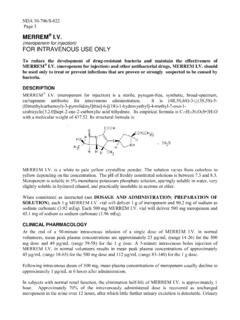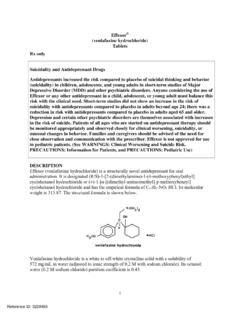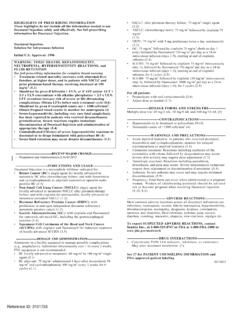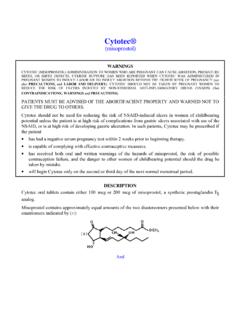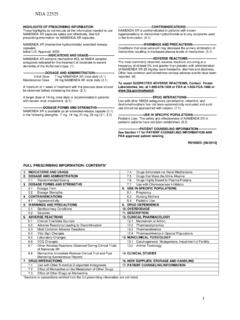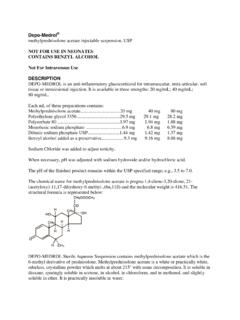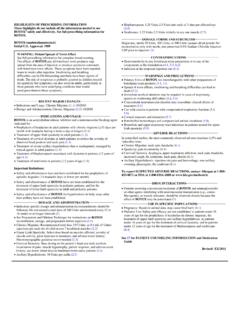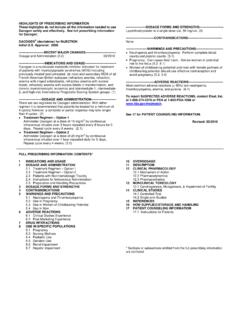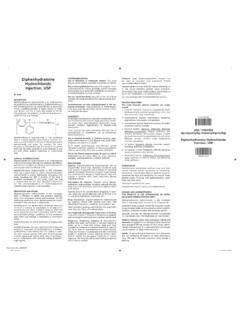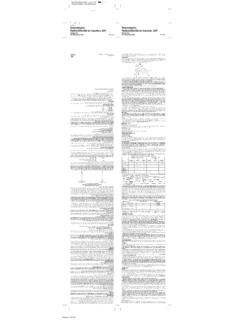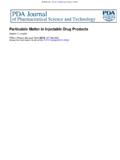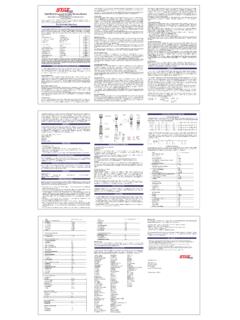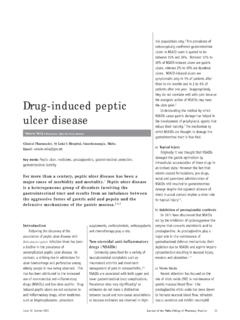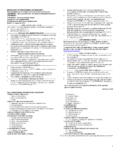Transcription of Venofer - Food and Drug Administration
1 NDA 21-135/S-017 Page 3 Venofer (iron sucrose injection, USP) Rx only DESCRIPTION Venofer (iron sucrose injection, USP) is a brown, sterile, aqueous, complex of polynuclear iron (III)-hydroxide in sucrose for intravenous use. Iron sucrose injection has a molecular weight of approximately 34,000 60,000 daltons and a proposed structural formula: [Na2Fe5O8(OH) 3(H2O)]n m(C12H22O11) where: n is the degree of iron polymerization and m is the number of sucrose molecules associated with the iron (III)-hydroxide. Each mL contains 20 mg elemental iron as iron sucrose in water for injection. Venofer is available in 5 mL single dose vials (100 mg elemental iron per 5 mL) and 10 mL single dose vials (200 mg elemental iron per 10 mL).
2 The drug product contains approximately 30% sucrose w/v (300 mg/mL) and has a pH of The product contains no preservatives. The osmolarity of the injection is 1,250 mOsmol/L. Therapeutic class: Hematinic CLINICAL PHARMACOLOGY Pharmacodynamics: Following intravenous Administration of Venofer , iron sucrose is dissociated by the reticuloendothelial system into iron and sucrose. In 22 hemodialysis patients on erythropoietin (recombinant human erythropoietin) therapy treated with iron sucrose containing 100 mg of iron, three times weekly for three weeks, significant increases in serum iron and serum ferritin and significant decreases in total iron binding capacity occurred four weeks from the initiation of iron sucrose treatment.
3 Pharmacokinetics: In healthy adults treated with intravenous doses of Venofer , its iron component exhibits first order kinetics with an elimination half-life of 6 h, total clearance of L/h, non-steady state apparent volume of distribution of L and steady state apparent volume of distribution of L. Since iron disappearance from serum depends on the need for iron in the iron stores and iron utilizing tissues of the body, serum clearance of iron is expected to be more rapid in iron deficient patients treated with Venofer as compared to healthy individuals. The effects of age and gender on the pharmacokinetics of Venofer have not been studied.
4 Venofer is not dialyzable through CA210 (Baxter) High Efficiency or Fresenius F80A High Flux dialysis membranes. In in vitro studies, the amount of iron sucrose in the dialysate fluid was below the levels of detection of the assay (less than 2 parts per million). Distribution: In healthy adults receiving intravenous doses of Venofer , its iron component appears to distribute mainly in blood and to some extent in extravascular fluid. A study evaluating Venofer NDA 21-135/S-017 Page 4 containing 100 mg of iron labeled with 52Fe/59Fe in patients with iron deficiency shows that a significant amount of the administered iron distributes in the liver, spleen and bone marrow and that the bone marrow is an iron trapping compartment and not a reversible volume of distribution.
5 Metabolism and Elimination: Following intravenous Administration of Venofer , iron sucrose is dissociated into iron and sucrose by the reticuloendothelial system. The sucrose component is eliminated mainly by urinary excretion. In a study evaluating a single intravenous dose of Venofer containing 1,510 mg of sucrose and 100 mg of iron in 12 healthy adults (9 female, 3 male: age range 32-52), of the sucrose was eliminated in urine in 4 h and in 24 h. Some iron also is eliminated in the urine. Neither transferrin nor transferrin receptor levels changed immediately after the dose Administration [1]. In this study and another study evaluating a single intravenous dose of iron sucrose containing 500-700 mg of iron in 26 anemic patients on erythropoietin therapy (23 female, 3 male; age range 16-60), approximately 5% of the iron was eliminated in urine in 24 h at each dose level [2].
6 drug - drug Interactions: drug - drug interactions involving Venofer have not been studied. However, like other parenteral iron preparations, Venofer may be expected to reduce the absorption of concomitantly administered oral iron preparations. CLINICAL TRIALS Venofer is used to replenish body iron stores in non-dialysis dependent-chronic kidney disease (NDD-CKD) patients receiving erythropoietin and in NDD-CKD patients not receiving erythropoietin, and in hemodialysis dependent-chronic kidney disease (HDD-CKD) and peritoneal dialysis dependent-chronic kidney disease (PDD-CKD) patients receiving erythropoietin. Iron deficiency may be caused by blood loss during dialysis, increased erythropoiesis secondary to erythropoietin use, and insufficient absorption of iron from the gastrointestinal tract.
7 Iron is essential to the synthesis of hemoglobin to maintain oxygen transport and to the function and formation of other physiologically important heme and non-heme compounds. Most dialysis patients require intravenous iron to maintain sufficient iron stores. Six clinical trials were conducted to assess the safety and efficacy of Venofer . Five studies were conducted in the United States (516 patients) and one was conducted in South Africa (131 patients). Study A: Hemodialysis Dependent-Chronic Kidney Disease (HDD CKD) Study A was a multicenter, open-label, historically-controlled study in 101 hemodialysis patients (77 patients with Venofer treatment and 24 in the historical control group) with iron deficiency anemia.
8 Eligibility for Venofer treatment included patients undergoing chronic hemodialysis three times weekly, receiving erythropoietin, hemoglobin concentration greater than and less than g/dL for at least two consecutive weeks, transferrin saturation < 20%, and serum ferritin < 300 ng/mL. The mean age of the patients in the treatment group was 65 years with the age range being 31 to 85 years of age. The erythropoietin dose was to be held constant throughout the study. The protocol did not require Administration of a test dose; however, some patients received a test dose at the physician s discretion. Exclusion criteria included significant underlying disease, asthma, active inflammatory disease, or serious bacterial or viral infection.
9 Venofer 5 mL containing 100 mg of elemental iron was administered through the dialysis line at each dialysis session either as slow injection or a saline diluted slow infusion for a total of 10 dialysis sessions with a cumulative dose of 1,000 mg elemental iron. A maximum of 15 mLs (300 mg of elemental iron) of Venofer was administered per week. NDA 21-135/S-017 Page 5 No additional iron preparations were allowed until after the Day 57 evaluation. The mean change in hemoglobin from baseline to Day 24 (end of treatment), Day 36, and Day 57 was assessed. The historical control population consisted of 24 patients with similar ferritin levels as patients treated with Venofer , who were off intravenous iron for at least 2 weeks and who had received erythropoietin therapy with hematocrit averaging 31-36 for at least two months prior to study entry.
10 The mean age of patients in the historical control group was 56 years, with an age range of 29 to 80 years. Patient age and serum ferritin level were similar between treatment and historical control patients. Of the 77 patients in the treatment group, 44 (57%) were male and 33 (43%) were female. The mean baseline hemoglobin and hematocrit, were higher and erythropoietin dose was lower in the historical control population than the Venofer treated population. Patients in the Venofer treated population showed a statistically significantly greater increase in hemoglobin and hematocrit than did patients in the historical control population.
